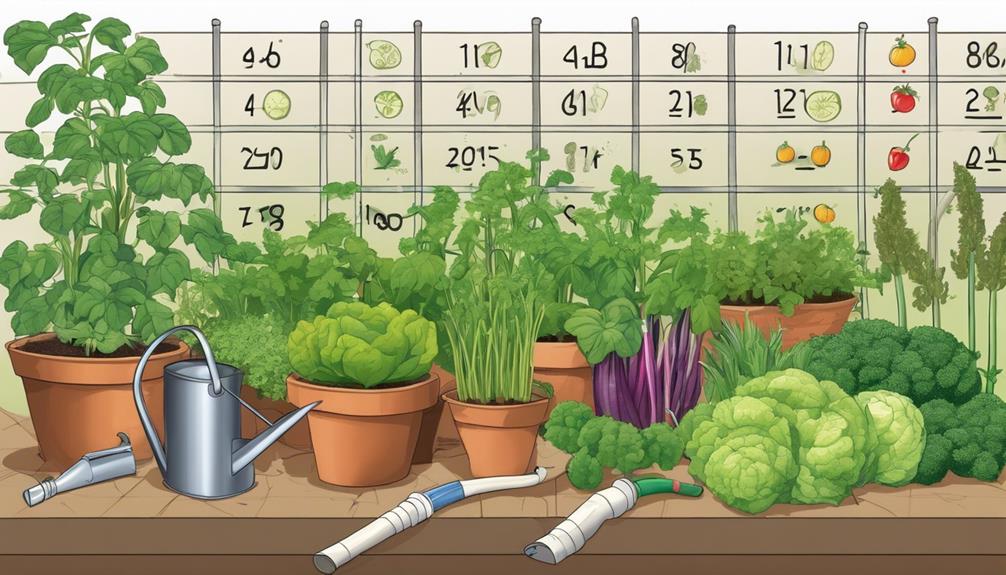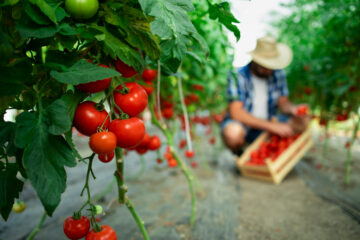When it comes to watering your home veggies, striking the right balance can be the key to a flourishing garden. Imagine a scenario where your vegetables are thriving, with vibrant colors and robust growth, all thanks to a well-thought-out watering schedule.
But what are the exact strategies that can lead you to this successful outcome? Stay tuned to discover the seven best watering schedules that will transform your vegetable garden and set you on the path to gardening triumph.
Daily Watering Schedule
For optimal growth of your home vegetable garden, avoid daily watering schedules to prevent overwatering and root rot. Vegetables thrive with deep watering rather than frequent shallow watering.
The amount of water your vegetable garden needs depends on factors like soil type and weather conditions. Aim to provide about 1 inch of water per week, adjusting based on the specific needs of your plants.
Deep watering encourages root development and helps plants become more drought-resistant. Consider using drip irrigation or soaker hoses for efficient and consistent watering.
Monitoring soil moisture levels is crucial to ensure you're providing adequate hydration without drowning the roots. By following these guidelines, you can help your vegetable garden flourish.
Weekly Watering Routine
Optimize your home vegetable garden's health by establishing a consistent weekly watering routine suited to your plant's specific requirements. Most vegetables need about 1 inch of water per week for optimal growth. Adjust the watering frequency based on weather conditions and the type of soil your plants are in; sandy soil may require more frequent watering than clay soil.
To determine the amount of water your plants need, use a rain gauge to measure weekly rainfall and supplement accordingly. Consistent watering is crucial for promoting healthy root growth and ensuring your plants thrive.
Consider using a drip system to deliver water directly to the soil surface, promoting a healthy plant without wastage.
Bi-Weekly Watering Plan
Wondering how to effectively manage watering for your home veggies on a bi-weekly basis?
When implementing a bi-weekly watering plan for your vegetable garden, it's crucial to adjust the watering frequency based on the specific needs of your plants and the moisture level of the soil.
Monitor the soil moisture regularly to ensure it doesn't dry out between waterings. In small spaces, where the root zone may be limited, providing adequate water every two weeks is essential for healthy plant growth.
Watering Guide by Vegetable Type
To ensure optimal growth for your home veggies, tailor your watering schedule based on the specific needs of each vegetable type. Different vegetables have varying requirements when it comes to watering. Cauliflower and celery need frequent watering, while corn should be watered when tassels form. Cucumbers benefit from watering when fruit forms, and lettuce, spinach, and leafy greens require consistent watering. Here is a handy guide to help you water your vegetables effectively:
| Vegetable | Watering Frequency | Pre-Harvest Water Amount |
|---|---|---|
| Cauliflower | 6 times per week | 6 gallons |
| Celery | 6 times per week | – |
| Corn | 6 times per week | – |
| Cucumbers | 3 times per week | – |
| Leafy Greens | 2 times per week | – |
Seasonal Watering Strategies
Consider adjusting your watering frequency based on seasonal changes and weather conditions to ensure optimal growth for your home vegetable garden.
In summer, when temperatures soar, your plants may require more water to prevent drought stress. Monitor soil moisture levels closely and water early in the day to reduce evaporation. For well-drained soil types, using a soaker hose can deliver water directly to the roots. Adding a layer of mulch helps retain moisture and regulate soil temperature.
During cooler seasons, water less frequently to avoid waterlogging, especially for plants in early stages of growth. Adjusting your watering schedule based on the specific needs of your garden can help prevent issues such as overwatering, particularly in clay soil.
Watering Frequency for Container Gardens
Adjust your watering frequency for container gardens as they typically demand more frequent watering than conventional garden beds due to faster soil drainage. To ensure your container plants thrive, follow these tips:
- Monitor soil moisture levels regularly, especially in hot weather.
- Consider using a moisture meter to accurately determine when to water your container plants.
- Water your container garden when the soil feels dry to the touch.
- Apply mulch to help retain soil moisture and reduce the need for frequent watering.
Customized Watering Schedule Tips
Wondering how to tailor your watering schedule to meet the specific needs of your plants? Customizing your watering routine based on factors like plant types, soil conditions, and weather patterns is crucial for promoting healthy growth. To create an effective schedule, consider using tools such as rain gauges, soil moisture meters, and watering charts to monitor soil moisture levels accurately. By adjusting the frequency and amount of water according to your plants' requirements and the environment they are in, you can ensure optimal growth and prevent issues like over or under-watering. Regular monitoring of plant health and weather changes will help you fine-tune your watering schedule for thriving home veggies.
| Key Aspect | Importance | Tools Available |
|---|---|---|
| Soil Type | Essential for plant needs | Soil Moisture Meter |
| Weather Conditions | Impact watering frequency | Rain Gauge |
| Plant Growth Stage | Determines water requirements | Watering Charts |
Frequently Asked Questions
How Often Should You Water Indoor Vegetable Plants?
You should water indoor vegetable plants when the top inch of soil feels dry to the touch. Check moisture levels with a meter or your finger. Adjust watering based on plant type, pot size, humidity, and temperature to thrive.
How Often Should You Water a Raised Vegetable Garden?
You water your raised vegetable garden as often as a thirsty flower in the desert, typically 2-3 times per week. Keep an eye on soil moisture levels, adjust based on plant needs, and consider drip irrigation for consistent hydration.
Which Vegetables Need Most Frequent Watering?
For thriving home veggies, you should know which ones need the most frequent watering. Cauliflower, celery, corn, cucumbers, and leafy greens like lettuce and spinach all benefit from regular watering to grow healthy and abundant.
Should I Water My Vegetable Garden Every Morning?
You don't need to water your vegetable garden every morning. Check soil moisture first. Water deeply but less often for healthy roots. Consider plant type, weather, and soil. Avoid overwatering. Moisture meters can help.
Conclusion
So there you have it – follow these watering schedules and watch your home veggies thrive!
Remember, the early bird catches the worm, so don't delay in implementing these tips.
By tailoring your watering routine to each vegetable type and staying consistent with your watering practices, you'll set yourself up for a bountiful harvest.
Happy gardening!





